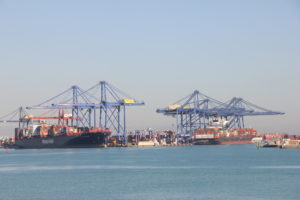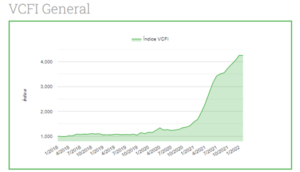
The VCFI stands at 4,254.52 points. Geopolitical tensions over Russia’s war with Ukraine and fuel prices will drive freight rates in the coming months
Oil and marine fuel prices rise to record highs
The Index has fallen in most of the areas surveyed. In the Far East, the fall was 1.73%, in a period marked by the Chinese New Year
The supply of ships continues to be conditioned by the high levels of congestion in some of the main ports of the world
Change of trend in the indicators that measure the evolution of container transport costs. Valencia Containerised Freight Index (VCFI) fell by 0.19% in February compared to the previous month. After a year and a half of increases, the VCFI breaks its upward dynamic and contracts slightly, in line with the behaviour recorded in recent weeks by other benchmark indices. Thus, the VCFI for February stands at 4,254.52 points, which means an accumulated growth of 325.45% compared to the beginning of the historical series in January 2018. Rising oil prices, geopolitical tensions, shipping traffic congestion in some ports and slowing demand in Asia are all weighing on the VCFI in February. The Index has fallen in most of the areas analysed, such as in the Far East where the drop was 1.73%.
During the last month analysed by the VCFI, inflationary tensions were a constant in many territories, with the energy component being one of the main protagonists. Thus, and during the geopolitical conflict caused by Russia’s invasion of Ukraine and after OPEC announced that it will maintain the planned gradual increase in its production, the barrel of European Brent crude oil increased by 12.28%, rising from $86.51 in January to $97.13 in February, the highest price since 2014. Uncertainty about the evolution of energy prices in the coming months is at its highest. In fact, the price of marine fuels has also reached record highs. Thus, considering the bunkering price of the 20 main ports in the world according to data provided by Ship&Bunker, the price of IFO 380 (Intermediate Fuel Oil) has risen from $557.50 in January to $591.50 in February, representing an increase of 6.09%. The price of VLSFO (Very Low Sulphur Fuel Oil) rose from $706 in January to $781.50 in February, an increase of 10.69%.
As far as shipping lines are concerned, and as Alphaliner points out, the capacity offered remains high for all vessel segments, with commercially inactive fleet levels at minimum levels. Specifically, in mid-February, 48 vessels were idle with a total of 101,419 TEU (standard 20-foot container), representing 0.4% of the total active fleet, a slightly lower figure than the January figures of 117,178 TEU and 0.5% of the total active fleet.
In this sense as has been usual in recent months, the supply has been conditioned by the high levels of congestion in some of the main ports of the world. According to the Southern California Marine Exchange (SCME), in the case of Europe the delay has ranged between 7 and 14 days while in the case of the USA the situation varies depending on the port, reaching a delay of 40 days in the worst case.
In terms of the analysis of the different areas that make up the VCFI, the general trend has been downward. Of particular note was the fall in freight rates from the Middle East (-2.66%), the Indian Subcontinent (-2.30%), the Far East (-1.73%) and East Coast Africa (-1%). On the other hand, freight rates in Latin America Atlantic (1.58%) and Africa West Coast (1.11%) increased.

VCFI Western Mediterranean
Regarding the Western Mediterranean sub-index, the decrease has been 0.18%, standing at 2,123.83 points, however, it is practically double that of February 2021. The cumulative growth in this area has been 112.38% compared to the beginning of the historical series. In terms of traffic from Valenciaport, a decrease in movements to Morocco was observed with respect to the previous month, below the levels reached in the same month of 2020 but still above the figure for 2019. In the case of traffic to Algeria and Tunisia, a clear decrease has been reported with respect to the previous month, positioning itself even below both 2020 and 2021.
VCFI Far East
The Far East area shows a decrease of 1.73% compared to January. The Index has reached 3,760.93 points and thus accumulating a growth of 276.09% if compared to the beginning of the series in January 2018.In this line, it is worth noting a drop in Valenciaport’s export flows with China, its main trading partner. Again, it is necessary to consider the seasonality of the moment, marked by the Chinese New Year, which could have contributed to the decrease in overall export flows to China due to the holidays and the closure of factories.

